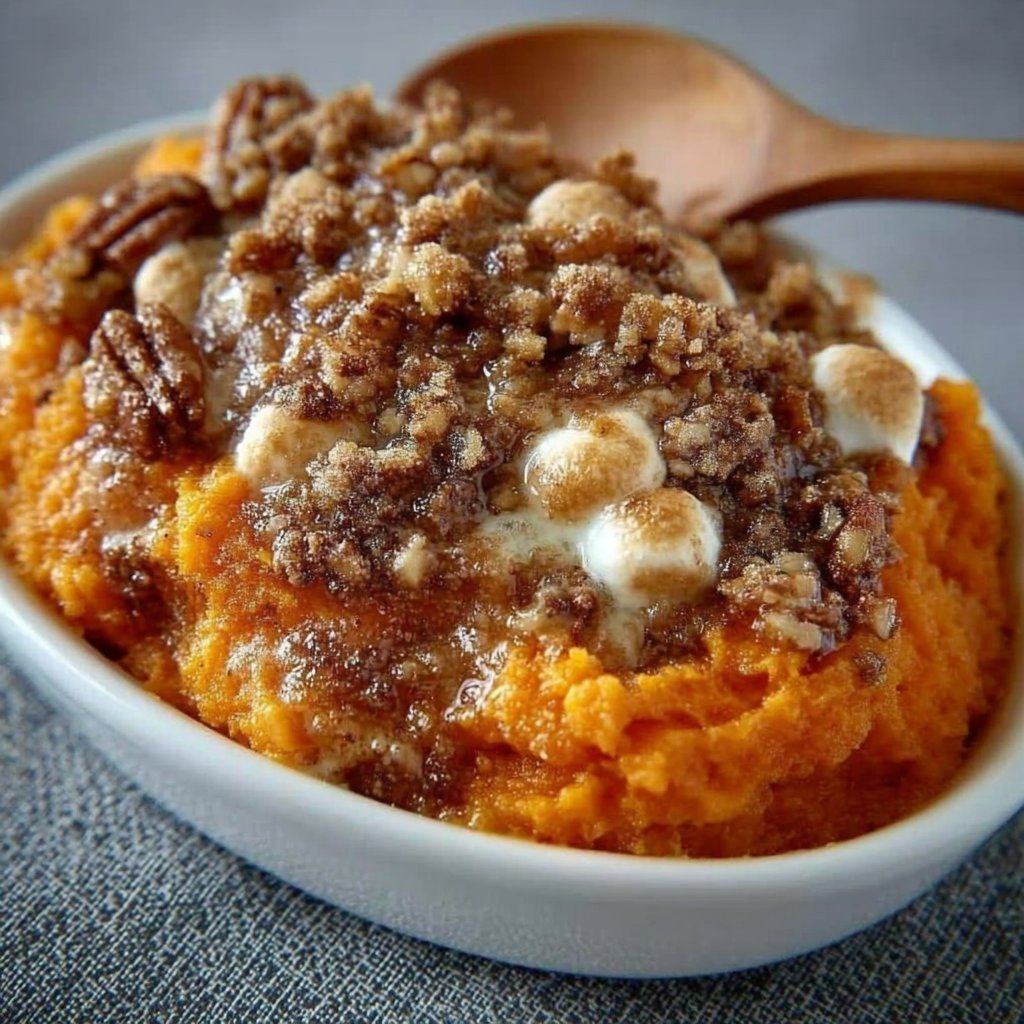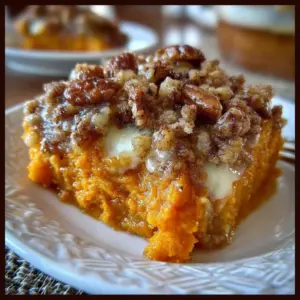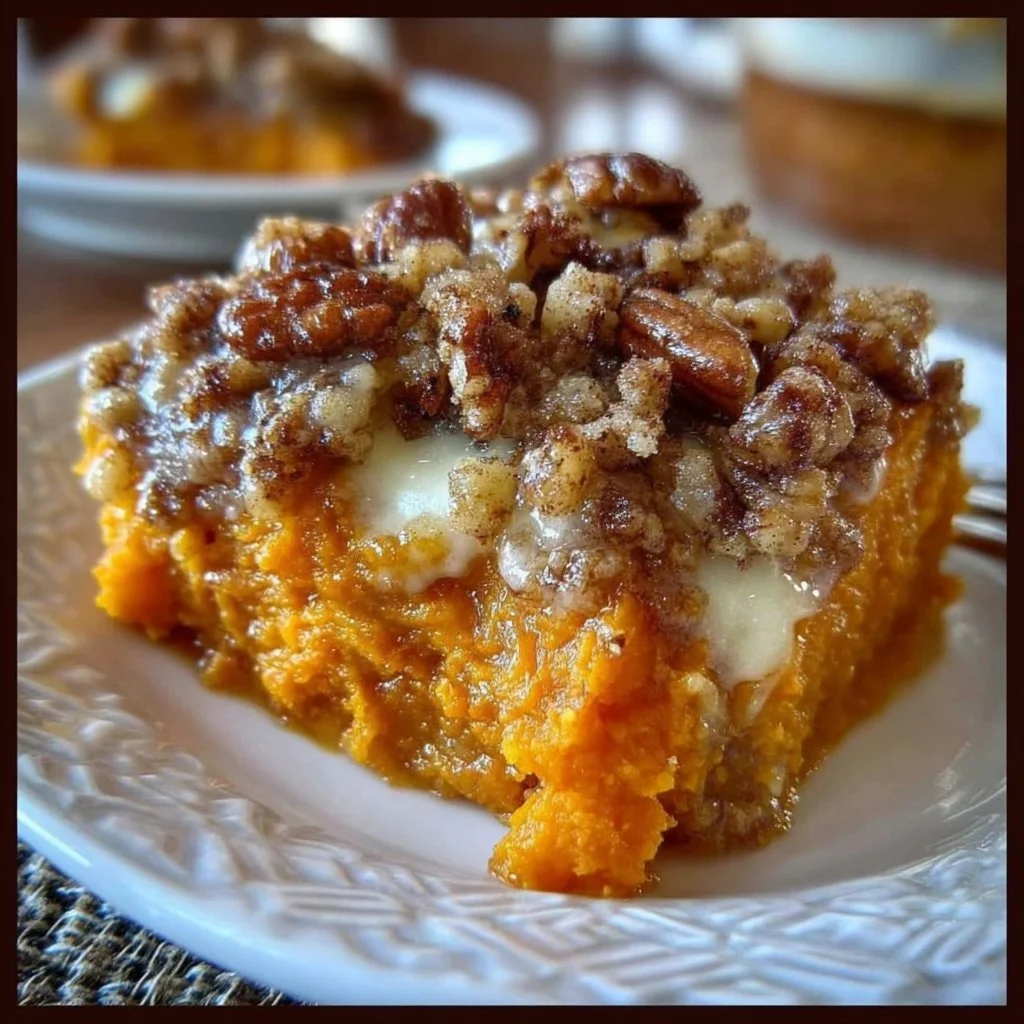Creamy, comforting, and just the right balance of sweet and crunchy — this Sweet Potato Casserole is the ultimate crowd-pleaser for family dinners and holiday tables. If you love dishes that feel like a warm hug, this one delivers: velvety mashed sweet potatoes baked under a buttery pecan crumble and, if you like, a golden layer of marshmallows. Fun fact: sweet potatoes were once believed to be an aphrodisiac in some cultures — who knew spuds could be so charming? Compared to other holiday sides, this casserole is refreshingly simple and quick to assemble, which makes it a go-to when you want something impressive without fuss. For another take on this classic, try our classic sweet potato casserole for more variations and serving ideas. Roll up your sleeves — this one’s easy, fast, and family-friendly.
What is Sweet Potato Casserole?
What exactly is a sweet potato casserole — is it a side dish, a dessert, or both? Think of it as the best of all worlds: mashed sweet potatoes combined with warm spices and topped with a crunchy, buttery pecan crumble (and sometimes fluffy marshmallows). How did it get its name? Maybe because it’s a casserole dish full of sweet potatoes — straightforward and honest, like a good joke at a family dinner. Rumor has it the dish became popular when busy home cooks wanted a make-ahead side that fed a crowd. And remember, “the way to a man’s heart is through his stomach.” Give this recipe a try and see whose heart you win over first.
Why You’ll Love This
- Irresistible texture: velvety, creamy sweet potatoes meet a crisp pecan crumble for a contrast that keeps every bite interesting.
- Budget-friendly: making this at home with a few pantry staples costs far less than store-bought sides or restaurant versions, and it stretches to feed a crowd.
- Flavor-packed toppings: the combo of brown sugar, cinnamon, butter, and pecans creates deep, toasty flavors that make this casserole feel festive and indulgent.
If you enjoy the nutty crunch here, you’ll also love the nuttier twist in our sweet potato pecan casserole, which adds more pecan-forward texture. Ready to bake? This one is worth making tonight.
How to Make
Quick Overview
This recipe is easy to prep, comforting to eat, and satisfying to serve. It features a creamy mashed sweet potato base, a buttery, cinnamon-spiked flavor profile, and a standout crunchy pecan crumble topping. Prep time is roughly 15–20 minutes if your sweet potatoes are already cooked, and baking takes about 30 minutes — total time around 45–50 minutes.
Ingredients:
- 4 cups Sweet Potatoes, cooked and mashed (about 2–3 large sweet potatoes), peeled and mashed until smooth
- 1/2 cup Brown Sugar, packed
- 1/4 cup Butter, melted
- 1/2 cup Milk (whole milk preferred for creaminess)
- 2 large Eggs, beaten
- 1 teaspoon Vanilla Extract
- 1/2 teaspoon Cinnamon, ground
- 1/2 teaspoon Salt
- 1 cup Pecans, chopped (for topping)
- 1/2 cup All-Purpose Flour (for topping)
- 1/4 cup Butter, softened (for topping)
- 1 cup Mini Marshmallows (optional, for topping)
Directions:
- Preheat oven to 350°F (175°C). Grease a 9×13-inch baking dish lightly with butter or nonstick spray so the casserole doesn’t stick and edges crisp evenly.
- In a large bowl, combine the mashed sweet potatoes, 1/2 cup brown sugar, 1/4 cup melted butter, 1/2 cup milk, beaten eggs, vanilla extract, cinnamon, and salt. Mix well until the mixture is smooth and slightly glossy. Use a rubber spatula for best scraping and blending.
- Spread the sweet potato mixture evenly into the prepared baking dish, smoothing the top with the back of a spoon or offset spatula so the crumble adheres nicely.
- In a separate bowl, combine the chopped pecans, 1/2 cup all-purpose flour, 1/4 cup softened butter, and an additional 1/4 cup brown sugar (if you like a sweeter topping). Use your fingers or a pastry cutter to mix until coarse crumbs form and pecans are well coated.
- Sprinkle the pecan topping evenly over the sweet potato mixture, covering the surface completely for a uniform crunch.
- Bake for 25 minutes in the preheated oven. If using marshmallows, remove the casserole after 25 minutes, sprinkle the 1 cup mini marshmallows evenly over the top, and return to the oven for an additional 5 minutes or until marshmallows are puffed and golden and the crumble is lightly browned. Watch closely to prevent over-browning.
- Let the casserole cool for a few minutes before serving to allow slices to set slightly. Serve warm with a spatula to scoop generous portions.

What to Serve With
- Roast turkey or baked ham for a classic holiday plate.
- Green bean almondine or sautéed garlic green beans for a fresh, crunchy contrast.
- Cranberry sauce or a bright herb salad to cut the richness with acidity.
- For beverages, try a mulled cider, a crisp white wine, or a sparkling water with citrus to balance sweetness.
Top Tips for Perfecting
- Swap milk: use half-and-half for extra creaminess or a non-dairy milk (almond or oat) for a lighter option.
- Make ahead: assemble the casserole and topping separately, refrigerate up to 24 hours, then bake until heated through and crisp.
- Toast pecans: briefly toast pecans in a dry skillet to amplify nutty flavor before mixing into the crumble.
- Avoid soggy topping: ensure the butter in the crumble is cold or just softened, not melted, for better crumb texture.
- Adjust sweetness: if you prefer less sweet, reduce total brown sugar by 2–3 tablespoons or skip the marshmallows.
- Watch marshmallows closely under the broiler: they can go from golden to burnt in seconds.
Storing and Reheating Tips
- Refrigeration: store leftovers in an airtight container or covered baking dish in the refrigerator for up to 4 days. Reheat individual portions in the microwave or reheat the whole dish in a 325°F oven until warmed through.
- Freezing: you can freeze the casserole (without marshmallows) for up to 2 months. Wrap tightly with plastic wrap and foil, then thaw overnight in the refrigerator before reheating. Add marshmallows only after reheating.
- Best reheating method: reheat in a 325°F oven covered with foil for 15–25 minutes, then uncover for 5–10 minutes to re-crisp the topping. For single servings, microwave in short intervals until hot, then briefly broil to restore crunch if desired.
FAQs
Can I use canned sweet potatoes?
Yes. Use drained, mashed canned sweet potatoes for convenience; reduce added milk slightly if the mixture seems too loose.
What size baking dish should I use?
A 9×13-inch baking dish works well. If using a smaller dish, baking time may increase slightly.
Can I make this gluten-free?
Yes. Substitute the all-purpose flour in the topping with an equal amount of gluten-free flour blend or almond flour for a nut-forward crumble.
Do I have to add marshmallows?
No. Marshmallows are optional. The pecan crumble is delicious on its own and keeps the dish less sweet.
How do I prevent the topping from burning?
If the edges brown too quickly, tent the dish loosely with foil during part of the baking time. Add marshmallows only at the end and watch them carefully.
Conclusion
This Sweet Potato Casserole is a must-make for anyone who loves comforting, easy-to-prepare sides that taste like homemade love. It’s forgiving, versatile, and perfect for weeknights or holiday feasts — and it proves that simple ingredients can create something memorable. For an extra marshmallow-topped inspiration, check out this helpful variation from Sweet Potato Casserole with Marshmallows. If you want another classic take to compare techniques and tips, see the Yummy Sweet Potato Casserole Recipe for additional ideas. Give this recipe a try, share it at your next meal, and enjoy the smiles it brings.

Sweet Potato Casserole
Equipment
- Mixing Bowl
- Baking Dish
Ingredients
Sweet Potato Base
- 4 cups Sweet Potatoes, cooked and mashed (about 2–3 large sweet potatoes)
- 1/2 cup Brown Sugar packed
- 1/4 cup Butter melted
- 1/2 cup Milk (whole milk preferred for creaminess)
- 2 large Eggs beaten
- 1 teaspoon Vanilla Extract
- 1/2 teaspoon Cinnamon, ground
- 1/2 teaspoon Salt
Topping
- 1 cup Pecans, chopped for topping
- 1/2 cup All-Purpose Flour for topping
- 1/4 cup Butter softened, for topping
- 1 cup Mini Marshmallows optional, for topping
Instructions
- Preheat oven to 350°F (175°C). Grease a 9×13-inch baking dish lightly with butter or nonstick spray.
- In a large bowl, combine the mashed sweet potatoes, brown sugar, melted butter, milk, beaten eggs, vanilla extract, cinnamon, and salt. Mix well until smooth.
- Spread the sweet potato mixture evenly into the prepared baking dish.
- In a separate bowl, combine the chopped pecans, flour, softened butter, and additional brown sugar. Mix until coarse crumbs form.
- Sprinkle the pecan topping evenly over the sweet potato mixture.
- Bake for 25 minutes. If using marshmallows, sprinkle them on top and return to the oven for an additional 5 minutes.
- Let the casserole cool for a few minutes before serving.

